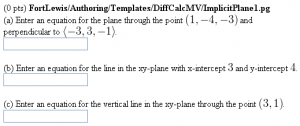Difference between revisions of "ImplicitPlane1"
(Removes the AnswerFormatHelp macro and some other cleanup.) |
(add historical tag and give links to newer problems.) |
||
| Line 1: | Line 1: | ||
| + | {{historical}} |
||
| + | |||
| + | <p style="font-size: 120%;font-weight:bold">This problem has been replaced with [https://openwebwork.github.io/pg-docs/sample-problems/DiffCalcMV/ImplicitPlane.html a newer version of this problem]</p> |
||
| + | |||
<h2>Answer is an Equation for a Line or Plane</h2> |
<h2>Answer is an Equation for a Line or Plane</h2> |
||
Latest revision as of 06:30, 18 July 2023
This problem has been replaced with a newer version of this problem
Answer is an Equation for a Line or Plane
This PG code shows how to define an answer that is a line or plane.
- File location in OPL: FortLewis/Authoring/Templates/DiffCalcMV/ImplicitPlane1.pg
- PGML location in OPL: FortLewis/Authoring/Templates/DiffCalcMV/ImplicitPlane1_PGML.pg
| PG problem file | Explanation |
|---|---|
|
Problem tagging: |
|
DOCUMENT(); loadMacros( 'PGstandard.pl', 'MathObjects.pl', 'parserImplicitPlane.pl', 'parserVectorUtils.pl', 'PGML.pl', 'PGcourse.pl' ); TEXT(beginproblem()); |
Initialization:
|
Context('ImplicitPlane');
Context()->variables->are(x=>'Real',y=>'Real', z=> 'Real');
$A = non_zero_point3D(-5,5,1);
$N = non_zero_vector3D(-5,5,1);
$answer1 = ImplicitPlane($A,$N);
$answer2 = ImplicitPlane('4x+3y=12');
$answer3 = ImplicitPlane('x=3');
|
Setup:
The first answer is a standard mulitivariable calculus question. There are several different ways to specify the input to
When the |
BEGIN_PGML
a. Enter an equation for the plane through the point [` [$A] `] and perpendicular to [` [$N] `].
+ [______________]{$answer1}
b. Enter an equation for the line in the [` xy `]-plane with [` x `]-intercept [` 3 `] and [` y `]-intercept [` 4 `].
+ [______________]{$answer2}
c. Enter an equation for the vertical line in the [` xy `]-plane through the point [` (3,1) `].
+ [______________]{$answer3}
[@ helpLink('equation') @]*
END_PGML
|
Main Text: |
BEGIN_PGML_SOLUTION Solution explanation goes here. END_PGML_SOLUTION |
Solution: |
